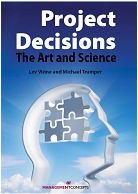Hardcover: 344 pages
Publisher: Management Concepts Inc
Language: English
ISBN-10: 1567262171
ISBN-13: 978-1567262179
Project management is the art of making the right decisions:
- How do you make accurate project estimations?
- How do you identify possible risks and assign probabilities to the risk events?
- How do you select viable project alternatives?
- How do you identify which project activity or risk is the most important?
- How do you account for the company’s or manager’s risk attitude?
In most cases the answers to these questions are not trivial. In projects we deal with multiple objectives, multiple risks and uncertainties, and multiple stakeholders. In addition, the underlying framework of project management problems can be very complex.
Fortunately, there is a practical set of methods and tools that can help solve these problems. It is called decision analysis. A unique aspect of decision analysis is that it involves two seemingly separate disciplines: psychology of judgment and decision-making and mathematics or statistics. Psychologists try to understand our underlying mental processes when we are making decisions. Mathematicians try to use their knowledge and utilize the numbers that surround project management in a meaningful way. In this manner, both mathematicians and psychologists are looking to develop methodologies that will improve our ability to make good decisions given the inherent limitations of our mental capabilities.
In recent years, decision analysis has become a practical tool in many disciplines. Companies routinely base their major investment strategies on the results of decision analysis and, in some industries, such as energy or pharmaceutical, companies never proceed with major projects without a comprehensive structured decision analysis. Decision science is used for the analysis of mergers and acquisitions, capital investment, reorganization, new product development, and in other areas. Governments use decision analysis as part of their policy development. Lawyers are using decision analysis to assess complex litigations that have uncertain outcomes. Decision analysis helps medical professionals to make correct diagnoses and prescribe the most effective treatments.
We came to the project management from a decision science background. We believe that project management should be a primary candidate for the application of decision analysis. However, we soon discovered that most organizations only use a few components of the decision analysis process. In addition, many project managers are not familiar with the decision analysis approaches that are in wide use in other industries, or if they are aware of the process, they do not believe that they are suitable for their discipline. When we started to make presentations about the psychology of judgment and decision-making in project management, it was an eye-opening experience for many project managers. At that point, we decided that the best way to get our message out to the widest audience would be to publish a book that would provide a short and practical introduction to decision analysis.
Project management is all about processes. Decision science provides processes that will help project managers improve their ability to make good decisions. In Part 1 of this book we outline the project decision analysis process. The subsequent four chapters describe each phase of the process in detail including a review of both the psychological aspects and quantitative methods. We have tried to avoid complex mathematical discussions as we believe in the maxim that the “knowledge of geography is unnecessary as long as there are taxi drivers”. In other words, complex mathematics and statistics is implemented in the myriads of software applications; therefore, you, as project managers, don’t need to know all details. Instead we want to concentrate on the psychology of decision-making, which we think is a terra incognito for many project managers. Decision-making is a fundamental skill of project managers that can be improved by training. If project manager can avoid known mental traps and follow certain thinking processes, the quality of project decisions can be significantly improved. Essentially this book covers
- How we think in project management;
- How we make rational choices;
- How we can improve our ability to make these choices;
- What tools are available to help us during this process and allow us to make better decisions.
- We hope that the book will be useful and entertaining for everybody involved in project management process: managers, members of project teams, project sponsors. As part of this effort, we tried to map decision analysis process to the project management process described in PMI’s A Guide to the Project Management Body of Knowledge (PMBOK® Guide). Good decision analysis includes risk analysis; therefore, the book can be useful for managers who want to established effective risk management process.
Finally, technical books are a lot like exercise machines. You make a resolution to get in shape or reduce your weight and buy an exercise machine, which you then use religiously for a couple of weeks. When you see a few results – you see your toes for the first time in years – your interest flags, tedium sets in, and eventually your treadmill or bike is collecting dust in the basement. The same situation happens with most technical books. You use it for a few weeks and are able to get a few small improvements, but the reading is so tedious and boring that you would rather poke yourself in the eye than read the next chapter. We really hope that it is not an issue with our book as we have tried to make it as interesting as possible.


